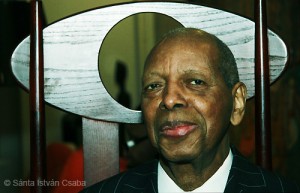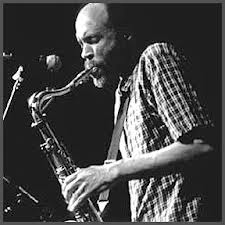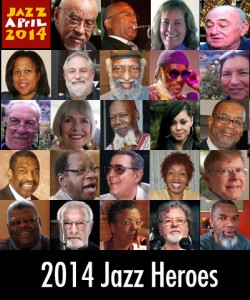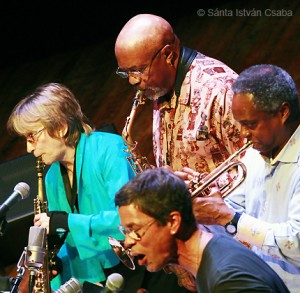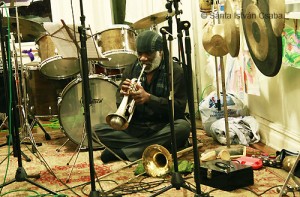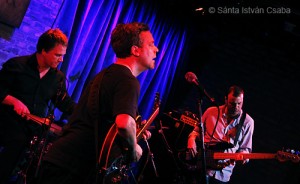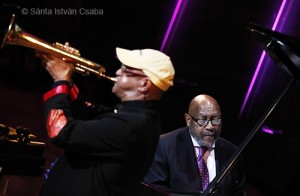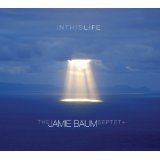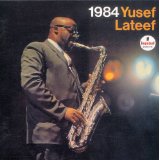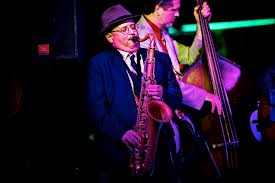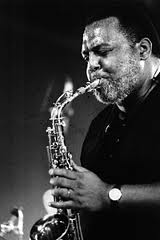Ornette Coleman recognizes beauty everywhere and in everyone.
Doris Duke Performing Artists of jazz beyond jazz
All these honorees are jazz convention-challengers, if not outright game-changers
Evolving jazz beyond jazz in March & JazzApril
Stunning, challenging and engaging if not always 100%, brilliantly revelatory music that goes beyond the strictest (old) definitions of jazz . . . What could music that’s free to tap all techniques, strategies and human capacities become?
What’s April for jazz?
[contextly_auto_sidebar id=”TaYwWrGCoDuKh6ci1uaZRz8TYOdaJssE”] We’re past April Fools Day  so I can safely say “Happy JazzApril” —  a shorthand hailing Jazz Appreciation Month (April, so designated in 2001 by the Smithsonian), culminating in International Jazz Day (April 30, first celebrated  in 2012 by UNESCO as advised by the Thelonious Monk Institute of Jazz). These officialized jazz occasions […]
“The Point Being” be here now with all you’ve got: Ray Anderson & Sarah Weaver
Trombonist Ray Anderson and composer/conductor Sarah Weaver at Roulette last Sunday hit a collaborative sweet spot. Their unusually mixed, all-star ensemble at Brooklyn’s creative music concert hall wove highly individualized solos into a continuous 50-minute set based on loose, humorous writing and spontaneous textural swells. Photographer Sánta István Csaba took photos while I just listened […]
Jazz in the ‘hood: house concerts make Brooklyn mighty
Jazz is local and homey, as well as grand and global — that’s what a house concert last weekend in Brooklyn shouted out. Transylvanian photographer Sánta István Csaba joined me at a “rare NYC performance” of 10³²K, the trio of trombonist Ku-umba Frank Lacy, bassist Kevin Ray and drummer Andrew Drury, at Drury’s apartment in […]
A weekend alt-guitar fest (photos)
The New York Guitar Festival this past weekend (Jan 17-19) featured master classes and three nights of “alternative guitar summits” curated by composer-guitarist Joel Harrison at the performance space Subculture. Photos by Sánta István Csaba from Friday night’s 30-minute sets by four trios, show the young men (all men) in the throes of plectralism and […]
NEA 2014 Jazz Masters’ investiture photo gallery
I’m reporting on the NEA Jazz Masters events for Down Beat, so reserve most comments ’til publication. But some controversies regarding the ceremonial events may emerge . . .
Henry Threadgill’s tribute to Butch Morris @ WinterJazz Fest 10
Composer-reedist Henry Threadgill created a stunning tribute at WinterJazz Fest 10 in New York City last night to honor his great friend Lawrence Douglas “Butch” Morris, who died just short of his 66th birthday on January 29, 2013. The nearly hour-long piece had two movements — a long, complex, multi-layered improvisation based on Threadgill’s score […]
Recommended 2013 jazz-beyond-jazz recordings
I’m interested in the jazz beyond “jazz” —  a genre very subjectively defined as exciting, enticing, sooo real recorded music to my ears. This list of “Best of 2013″ follows from the format critic Francis Davis designed for the NPR Music Jazz Critics’ Poll, with one significant difference. Francis asks, reasonably enough, that contributors to his poll refrain from voting […]
Unforgettable sounds and best videos of Yusef Lateef
I’ll never forget (I hope) Yusef Lateef’s flute wafting out from the stage of  the 1973 Ann Arbor Blues and Jazz Festival . . . Or his head-shaved, suited image on the cover of the boldly-named album 1984 (released in 1965, and not as dark as I’d expected) . . . Or his galvanizing spontaneous duet […]
14 performances — varied sounds — in six weeks
In the past 6 weeks I’ve heard a lot of live music  — though just a patch on what I’d like to have gotten to. In reverse chronological order: Sunday night 11/24: Adam Rudolph improvisationally conducting five flutists from his Go: Organic Orchestra at The Stone, then adding in his Moving Pictures septet. Earlier in the eve: trombonist […]
Let us now praise, help and hear should-be-famous jazz men
Two celebratory benefit jazz concerts in New York City this weekend: tonight (11/22) a tribute to alto saxophonist Arthur Blythe featuring his fellow altoist Oliver Lake, poet/cultural critic Amiri Baraka, tubaist Bob Stewart and guitarists Kelvyn Bell and Vernon Reid, among others at Shapeshifter Lab in Brooklyn; Sunday (11/24) starting at 4 pm a 78th birthday show for trombonist Roswell Rudd at (le) Poisson Rouge, where […]

